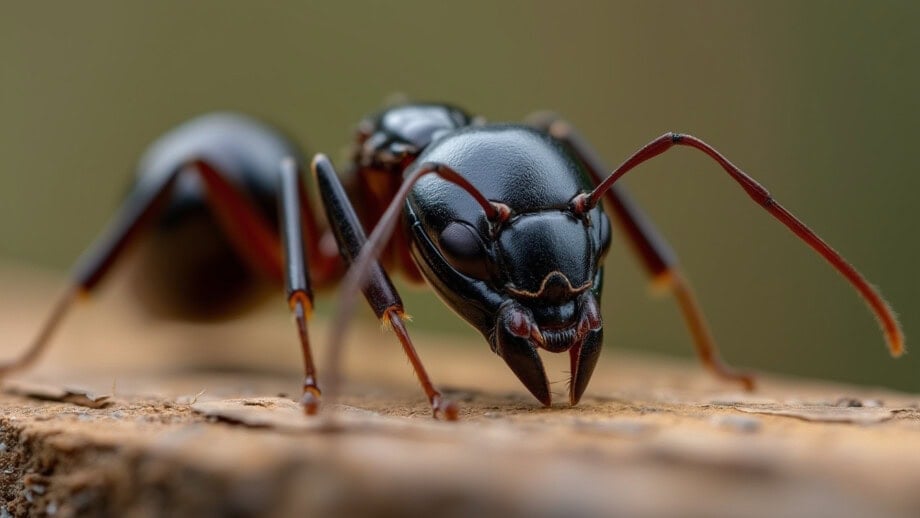How to Get Rid of Carpenter Ants by Yourself Easily
Proven, natural and organic treatments for getting rid of carpenter ants in the house and outside.

Few pests cause more panic around the home than those involving wood-destroying insects. Carpenter ants (Camponotus spp.) damage wood by tunneling and nesting inside it.
However, unlike termites, they do not feed on wood, but burrow into it to build their nests. They usually prefer damp, decaying lumber that is easy to excavate and rarely cause harm to sound structures.
Read on to learn everything you need to know about carpenter ants, including how to get rid of them yourself!
What are Carpenter Ants?
Carpenter ants (Camponotus spp.) are so named due to their habit of excavating. These ants construct wood nests both indoors and outdoors. Even though they take wood out of the way when they tunnel, they don’t eat it.
Instead, these ants feed on various kinds of insects, meats, pet food, pet food, syrup, honey, sugar, jelly, and other sweet items.
Also, they prefer honeydew, a sweet substance released by aphids. In fact, carpenter ants actively pursue aphids as a source of food.
How to Identify Carpenter Ants?
Carpenter ants are large (3/8 – 3/4 inch long) when compared to most ants and black, reddish-brown or yellowish in color, depending on the species.
They are often found inside during spring. However, their presence is not sufficient enough evidence to conclude that there is a problem inside your home.
Concerned homeowners should try to determine whether the ants are coming from an outdoor or an indoor nest, although this can be difficult.
According to the University of Minnesota Extension Service, if you find carpenter ants in your home during late winter or early spring, that suggests the ants are coming from a nest inside your house.
However, if you see activity later in the year, it is less clear if the nest is inside our outside.
In almost all cases, ants seen indoors during winter months are an indication that there is an inside nest. One exception is when ants are brought indoors in firewood.
Carpenter ants have large mandibles that assist them in excavating. They have two sets of wings and a pinched waist. The back wings are shorter than the front wings.

Life Cycle of a Carpenter Ant
Ant colonies are founded by a single fertilized queen which lays approximately 15-20 eggs after establishing a nesting site in a cavity in wood.
She feeds the developing young with salivary secretions and does not eat or leave the nest during this time. The queen has few duties except to lay eggs.
The workers who are reared first assume the task of gathering food with which to feed the younger larvae. They are also responsible for excavating galleries to enlarge the nest and tending the eggs, larvae, and pupae of the next generation.
Colonies grow very rapidly and reach a peak population (approximately 3,000 workers) within 3-6 years. At this time, winged reproductive females are produced and fly off to establish new colonies.
Top 3 Reasons Why There are Carpenter Ants in Your Home
Every time a pest enters your house, there is typically a reason behind it. Here are a few reasons why there might be carpenter ants in your home:
Foraging for Food
If you see carpenter ants inside your home, there doesn’t need to be an infestation inside your home currently. Instead, these ants may be in your home looking for food.
Worker ants venture outside the nest in search of food sources, which they bring back to the nest and share with the colony.
Moisture Damage
Carpenter ants like damp or rotting wood, which means that if there is a carpenter ant infestation in your house, you might have moisture damage in your structure or fittings.
A Nest is Nearby
Unfortunately, carpenter ants may be present in your house if their colony is close to your yard or home. Regardless of what the reason is, it’s time to act fast and get rid of them.
Signs of a Carpenter Ant Infestation
Catching a carpenter ant infestation early is important to avoid damage to your home. Check out a few signs that these ants have invaded.
Seeing Carpenter Ants in Your Home
Worker ants leave the nest to go out and find food for the colony. Seeing these ants indicates an infestation.
Finding Ant Wings
Swarming carpenter ants lose their wings after mating. Typically, discarded wings near doors and windows indicate a carpenter ant infestation.
Spotting Wood Shavings
As they tunnel, carpenter ants clear away any dead insects and wood that are in their way. These wood shavings, known as frass, can be found along walls, on the floor, and beneath wooden objects.
Discovering Small Holes in Wood
Even though carpenter ants prefer to remain hidden, they occasionally leave behind little signs of their presence. An infestation of carpenter ants can be detected by finding small, round holes in wood. They use this opening to remove wood debris from their nests.
Carpenter Ant Threats: What Type of Damage Can They Cause?
When it comes to insects and pests, it’s important to figure out whether they are a threat to our health.
Carpenter ants, fortunately, do not represent a serious threat to your health since they do not carry diseases. And while their bites can be painful, they are not harmful and they do not bite frequently.
However, they might represent a severe threat to your home’s structure. They make their nests by hollowing out wood, so if they sneak into your home’s wall gaps and remain there unnoticed, they might do significant damage.
The good news is that carpenter ants take longer to work and cause less damage than termites.
They are also simpler to spot since they have to leave the nest to search for food. Still, if you see signs of a carpenter ant infestation, you need to act quickly.
Carpenter Ants vs Termites
Sometimes, termites and carpenter ants are confused. Both pests cause damage to wood, but they are not the same and should be treated differently.
Both pests cause damage to wood, but they are not the same and should be treated differently.
Unlike carpenter ants, termites feed on wood. They have pairs of wings with identical lengths, whereas carpenter ants have wings of varying lengths.
The shape of their antennae is also different. Carpenter ants have bent antennae, whereas termites have straight antennae.
Carpenter Ant Prevention
Prevention is better than cure, as they say, and so it’s always a great idea to prevent carpenter ant infestations in the first place.
Here’s what you can do to prevent carpenter ants from invading your home:
Prevent Moisture Accumulation
Prevent excess moisture accumulation in wood through good maintenance of the house structure and surroundings.
Repair Existing Damage
If you’ve found and treated for carpenter ant infestation, it’s important to address the damage. Repair existing damage then cut off ant access routes.
Repair Injured Trees
Eliminate potential nesting areas by repairing injured trees and removing stumps and wood debris.
Prune Branches
Prune branches that touch the house and eliminate wood/earth contact with structures.
Check Firewood Carefully
Check firewood carefully for insects before bringing inside and monitor closely once the wood warms. It’s recommended to store your firewood off the ground and as far from the house as practical.
Apply Treatment to Wood
Apply Bora-Care directly to all untreated wood surfaces. Its patented formula penetrates deep into wood and provides long-lasting protection against boring insect damage.
How to Locate a Carpenter Ant Nest
If you feel like there’s an active carpenter ant infestation in or around your home, you need to get rid of them.
But to do that, it’s important to first locate a carpenter ant nest. Killing individual ants that are out and about will do little to solve the problem and so we need to directly address the nest.
Here’s what you can do to help you find the location of the nest:
Check Damp Areas
When looking for a nest, try checking in places close to water leaks like bathrooms, under sinks, or around window and door frames. These ants prefer to build their nests in wet, decaying wood.
Look for Signs of Infestation to Spot Them
If you see holes in the wood or unusual piles of sawdust, there’s a strong likelihood a nest is close. See if you can spot any carpenter ants nearby.
Follow Their Trails to Find the Nest
If you see a trail of foraging ants, you should follow them. They will likely take you to their nest.
When these ants move, they leave behind pheromone trails, which other ants can use to follow them to and from the food sources.
Be patient as you trace them back to baseboards, cabinets, doors, or other wooden structures. If they have nested in tree stumps or dead trees, you might even need to follow them outside.
However, there’s a chance that you don’t actually spot any carpenter ants out and about while looking for them, even if you have a carpenter ant infestation. If so, you might need to use some bait to lure them out.
You can use diluted honey or sugar milk as an easy DIY carpenter ant bait in this situation.
Carpenter ants are most active at night, so this is when you’ll have the best chance to spot them and use bait.
Use Sounds and Rustling Noises to Find a Nest
Try to locate the source of any rustling sounds you hear. Tap your walls to check if you can find any hollow spots that may be home to a carpenter ant nest.
How to Get Rid of Carpenter Ants
Effectively getting rid of carpenter ants is not as simple as killing each ant you see. It’s important to try these methods on the nest itself. Here are the top ways to get rid of carpenter ants at home:
Use Insecticides
Using an insecticide that has pyrethroids as an active ingredient is the most common way to get rid of carpenter ants. The key is to get insecticide spray or dust inside the nest.
You should never spray liquids near electrical outlets or junction boxes, but you can use insecticide dust there instead.
You can spray into any existing cracks, but to reach the colony, you will most likely need to drill new holes into the wall voids or hollow doors. Always follow the directions on the pesticide container when using it.
Also, only use it on nests; eradicating the problem by eliminating individual worker ants will have little effect on your carpenter ant infestation.
For an organic option, consider applying Insect Killer Granules around foundations, lawns, and landscaped areas to eliminate or repel all kinds of troublesome insects.
If pest populations become intolerable, spot treat with a fast-acting botanical insecticide. These natural sprays have shorter half-lives and less toxicity than commercial chemical pesticides.
Try Baits
Using baits involves applying the poisoned bait along the ants’ walking paths for them to pick up and bring back to the nest.
Broadcast least-toxic, weather-resistant TERRO Ant Bait Plus around exterior structures, trees, stumps, and firewood piles. Reapply every four weeks, as needed.
Apply Desiccants like Diatomaceous Earth
Desiccants are substances that dehydrate insects and kill them by removing their outer protective covering.
Diatomaceous earth is a great one that you can use at home and is non-toxic to people and animals. You can apply it to nests the same way you would use insecticidal dust.
To do this, locate nests by trailing workers and searching for frass piles (insect feces) and sawdust like wood shavings. If nests are found, apply non-toxic diatomaceous earth or boric acid powder to eliminate colonies.Add New
Other Ant Guides from Planet Natural:
How to Get Rid of Fire Ants (Red Imported Fire Ant Control)
How to Get Rid of Ants (Methods That Actually Work)
Sugar Ants Explained (with Photos) + DIY Removal Instructions













